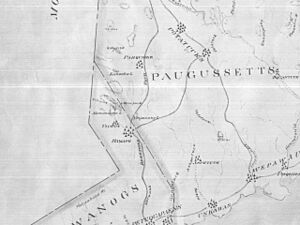Katonah (Native American leader) facts for kids
Quick facts for kids
Katonah
|
|
|---|---|
| Ramapo leader | |
| Preceded by | Powahay |
| Personal details | |
| Resting place | Katonah's Wood, off Rt. 22 |
| Spouses | Cantitoe, also called Mustato |
| Relations | Father, Onox (the older); grandfather, Ponus. Uncles, Tapgow (Taphance) and Owenoke. Brother, Onox (the younger). Eldest son, Wackemawa (Wawkamawe), Son, Papiag (Pohag); daughter married Sam Mohawk (Chickens Warrups) |
| Children | Wackemawa, Papiag |
| Parent | Onox |
| Signature |  |
Katonah was an important Lenape leader, known as a sachem, in the late 1600s and early 1700s. He led parts of two Native American groups, the Wappinger people. These groups lived in what is now southeastern New York State and southwestern Connecticut.
One group Katonah led was the Wiechquaeskeck, who lived near today's Greenwich and Stamford in Connecticut. The other group was the Ramapo, who lived in the area of modern-day Bedford, New York. The town of Bedford was actually bought from Chief Katonah.
Chief Katonah's Life and Leadership
Katonah was a sachem, or chief, of the Ramapo people. The Ramapo were a group of Wappinger people. Today, many of their descendants are known as the Ramapough Mountain Indians, living mostly in New Jersey. Katonah lived in this area during the late 1600s.
In 1708, settlers from Ridgefield, Connecticut, wanted the Ramapo people to move. Katonah sold about 20,000 acres of Ramapo land to these settlers for 100 Pounds Sterling. His name appears on land sale documents until 1743. After this, the remaining Ramapo people moved to other areas, mostly to the north and west.
Katonah came from a family of leaders. His father was Onox (the elder), and his grandfather was Ponus, who was a sachem of the Rippowams. Katonah became chief after his brother, Powahay. Katonah also had another brother named Onox and a son named Papiag. Both his brother and son also signed land deeds. Katonah's uncle, Tapgow, also signed many land deeds in northern New Jersey.
Katonah was married to a woman named Cantitoe, who was also called Mustato. She was said to be from the Pompton tribe. Their daughter married Samuel Mohawk, also known as Chickens Warrups.
There is a story that Katonah died from sadness after his wife and son were killed by lightning. It is said that he is buried with them in a place called Katonah's Wood, near New York State Route 22. A poem by William Will, called Katonah, describes him buried under a large rock, with his wife and son under two smaller rocks nearby.
Katonah's Legacy
Chief Katonah's name lives on in the area. The small town, or hamlet, of Katonah, New York, which is part of Bedford, is named after him.
In 2007, a company called Martha Stewart Living Omnimedia tried to trademark the name "Katonah" for a furniture line. Members of the Ramapough Lenape Nation and local residents worked together to stop this. They felt it was important to protect the name and its history.


